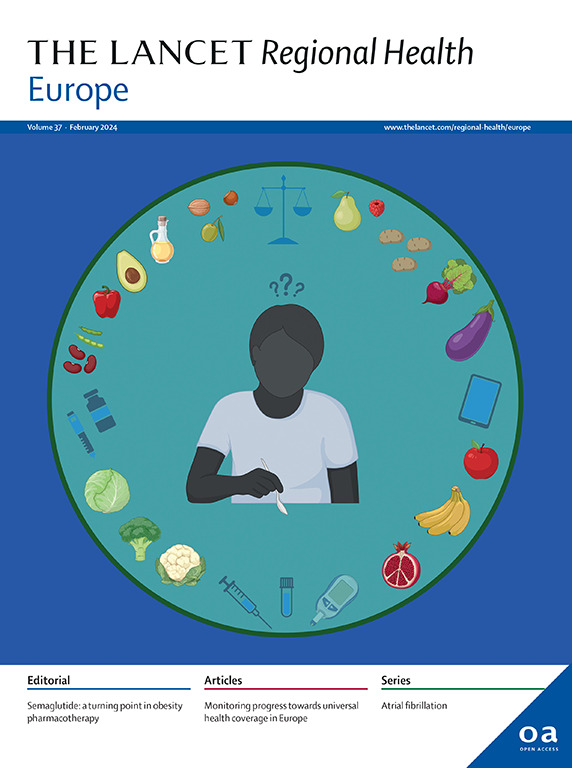Diagnostic accuracy and predictive value of the QuantiFERON-TB gold plus assay for tuberculosis in immunocompromised individuals: a prospective TBnet study
IF 13
Q1 HEALTH CARE SCIENCES & SERVICES
引用次数: 0
Abstract
Background
In low tuberculosis (TB)-endemic countries, tuberculosis preventive therapy (TPT) is recommended for immunocompromised individuals with a positive immunodiagnostic test. This study aimed to assess the performance of the QuantiFERON-TB Gold Plus (QFT+) assay and predictive power for future tuberculosis in immunocompromised individuals.
Methods
In this prospective observational study, immunocompromised adults ≥18 years of age including people living with HIV (PLHIV), chronic renal failure, rheumatoid arthritis, solid-organ transplantation or stem-cell transplantation, and immunocompetent adults with and without TB-disease were recruited at 21 sites in 11 European countries and tested with the QFT+ assay. Individuals without TB-disease were followed up for the development of tuberculosis. TB incidence rates (IR) were calculated, stratified by QFT+ results and acceptance of TPT. This study is registered with Clinicaltrials.gov, NCT02639936.
Findings
A total of 2663 individuals (1115 female, 1548 male) were enrolled from 03/11/2015 to 29/03/2019. Persons without tuberculosis were followed up for at least two years. Among 1758 immunocompromised individuals without active tuberculosis, 13.6% had positive QFT+ results. Sensitivity and specificity for TB-disease were 70.0% (52.1–83.3%) and 91.4% (89.6–92.9%), respectively, in immunocompromised, and 81.4% (76.6–85.3%) and 96.0% (92.5–97.9%), respectively, in immunocompetent individuals. During 2457 cumulative years of follow-up among 932 individuals with chronic renal failure, rheumatoid arthritis, solid-organ transplantation or stem-cell transplantation, including 83 persons with a positive QFT+ test without TPT, no-one developed active tuberculosis. In contrast, among 642 PLHIV without TPT, one with an indeterminate QFT+ and 3/30 individuals with a positive QFT+ developed active tuberculosis; all had detectable HIV-replication and low CD4 T-cell counts (incidence 4.1 (95% CI (1.3–12.4) per 100 person-years). No individuals receiving TPT developed active tuberculosis during 269 years of follow-up.
Interpretation
In immunocompromised individuals in low TB-endemic countries, the 2-year-risk for active tuberculosis was highest among PLHIV with detectable HIV-replication and low CD4-counts. In this study, the QFT+ assay did not strongly predict progression to active tuberculosis, which emphasises the need to incorporate additional risk factors.
Funding
None.
QuantiFERON-TB金加试验对免疫功能低下个体结核病的诊断准确性和预测价值:一项前瞻性TBnet研究
背景:在低结核病流行国家,推荐对免疫诊断试验阳性的免疫功能低下个体进行结核病预防治疗。本研究旨在评估QuantiFERON-TB Gold Plus (QFT+)检测的性能和对免疫功能低下个体未来结核病的预测能力。在这项前瞻性观察性研究中,在11个欧洲国家的21个地点招募了免疫功能低下的成年人(≥18岁),包括艾滋病毒感染者(PLHIV)、慢性肾衰竭、类风湿性关节炎、实体器官移植或干细胞移植,以及有或没有结核病的免疫功能正常的成年人,并使用QFT+检测。对未患结核病的个体进行结核病发展随访。计算结核发病率(IR),并根据QFT+结果和TPT接受度进行分层。本研究已在Clinicaltrials.gov注册,编号NCT02639936。研究结果2015年11月3日至2019年3月29日共入组2663人,其中女性1115人,男性1548人。没有结核病的人被随访了至少两年。在1758例无活动性肺结核的免疫功能低下个体中,13.6% QFT+阳性。免疫功能低下者对结核病的敏感性和特异性分别为70.0%(52.1-83.3%)和91.4%(89.6-92.9%),免疫功能正常者对结核病的敏感性和特异性分别为81.4%(76.6-85.3%)和96.0%(92.5-97.9%)。在2457年的累计随访中,932例慢性肾衰竭、类风湿关节炎、实体器官移植或干细胞移植患者,包括83例QFT+试验阳性但不含TPT的患者,没有人发生活动性结核病。相比之下,在642例无TPT的PLHIV中,QFT+不确定者1例,QFT+阳性者3/30发展为活动性结核;所有人都有可检测到的hiv复制和低CD4 t细胞计数(发病率4.1 (95% CI(1.3-12.4) / 100人年)。在269年的随访期间,没有接受TPT治疗的个体发生活动性结核病。在低结核病流行国家的免疫功能低下的个体中,2年活动性结核病的风险在可检测到hiv复制和cd4计数低的PLHIV中最高。在这项研究中,QFT+检测不能强有力地预测活动性结核病的进展,这强调了纳入其他危险因素的必要性。
本文章由计算机程序翻译,如有差异,请以英文原文为准。
求助全文
约1分钟内获得全文
求助全文
来源期刊

Lancet Regional Health-Europe
Multiple-
CiteScore
19.90
自引率
1.40%
发文量
260
审稿时长
9 weeks
期刊介绍:
The Lancet Regional Health – Europe, a gold open access journal, is part of The Lancet's global effort to promote healthcare quality and accessibility worldwide. It focuses on advancing clinical practice and health policy in the European region to enhance health outcomes. The journal publishes high-quality original research advocating changes in clinical practice and health policy. It also includes reviews, commentaries, and opinion pieces on regional health topics, such as infection and disease prevention, healthy aging, and reducing health disparities.
 求助内容:
求助内容: 应助结果提醒方式:
应助结果提醒方式:


